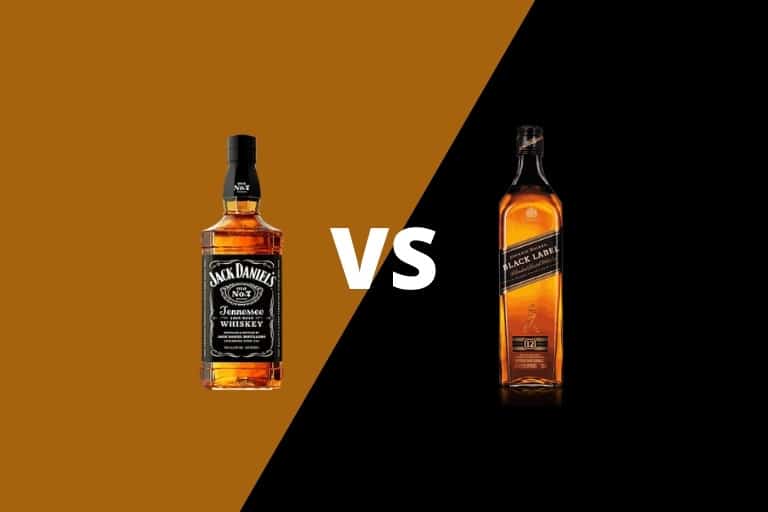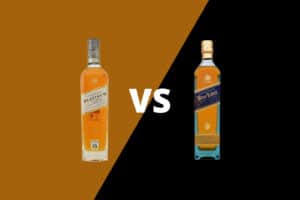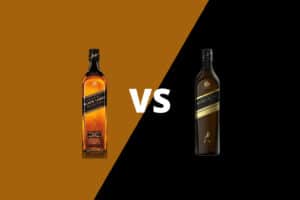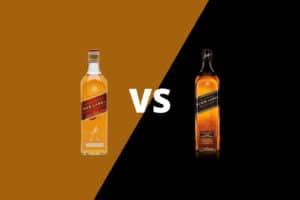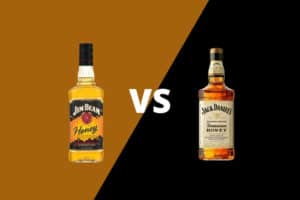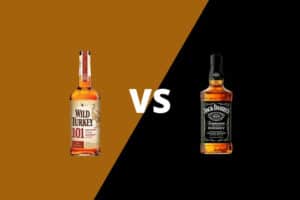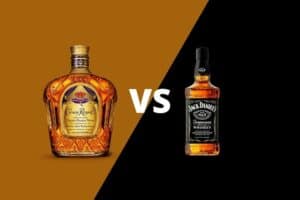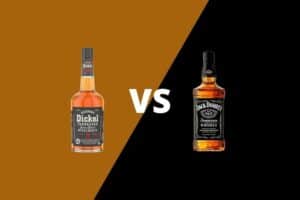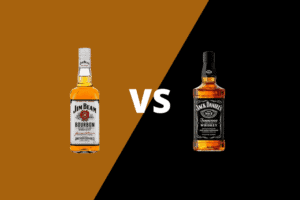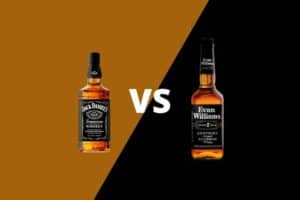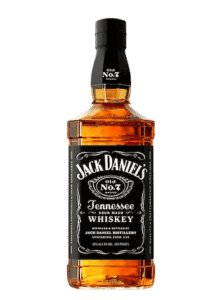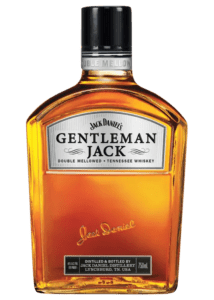The fight for global supremacy in the world of whiskey comes down to these two brands — which represent the whiskey-making traditions of two continents. It’s a contentious story between two brands and their ownership entities that fight for the hearts, minds and palates of a global whiskey-drinking audience — a battle for public opinion that has even spilled over into the court of law.
In fact, both brands have a valid claim as the No. 1 selling whiskey in the world. Seems impossible, but it’s true.
One note on spelling: The Scots use ‘whisky,’ while Americans use ‘whiskey.’ As a result, you will see both spellings as we try to accurately reflect the nomenclature of each respective production region.
Table of Contents
History
John Walker and Jack Daniel were both historical characters born into the 1800s with distinctive paths to the world of whiskey.
John Walker was born in Kilmarnock, Scotland, in the county of Ayrshire. His family sold the farm after his father died in 1819 and purchased a grocery shop and warehouse on the town’s High Street. Despite forgoing drink as a teetotaler, Walker oversaw the shop’s assortment of rum, gin, brandy and scotch whisky.
It was a fortuitous time to get into the scotch business.
Irishman Aeneas Coffey invented and patented his continuous still in 1833, forever changing the distilled spirits industry. As a result, Walker could sell not only sell single malt scotches from throughout Scotland, but he was also among the first to peddle the new inexpensive grain whiskies that began proliferating the marketplace.
John Walker died in 1857, so when the Spirits Act of 1860 passed in the U.K. Parliament and allowed brokers to blend malt and grain whiskies together, his son Alexander Walker reaped the benefit of the new blended scotch whisky style. That same year, Alexander introduced the square bottle with a tilted label. Together with his son Alexander Walker II, they built the brand into an international sensation.
The company acquired several distilleries throughout the end of the 19th and early 20th centuries, including Cardu, Coleburn, Clynelish, Dailuaine and Talisker. In 1925, Johnnie Walker joined the Distillers Company, which was a global leader in scotch whisky at the time. Guinness purchased Distillers Company in 1986, which then merged with Grand Metropolitan to form Diageo, PLC, in 1997. Today, Diageo is the largest drinks business on the planet.
Some colorful anecdotes about Johnnie Walker include that it was Winston Churchill’s favorite scotch during World War II and that it has enjoyed a royal warrant from the monarch of England since 1934.
Jasper ‘Jack’ Newton Daniel was born in Lynchburg, Tennessee, in 1849. He learned the art of distilling on the site of a neighbor’s distillery from a slave named Nearest Green. After the Civil War ended, Jack Daniel hired Nearest to run the stills of the distillery he built in 1875. Together, they perfected their whiskey style and began selling it throughout Reconstruction Tennessee.
The Jack Daniel’s brand was acquired by the Brown-Forman company in 1956. Under corporate leadership, the brand began a push into live music venues, where the distinctive square bottles with white font on black labels became associated with the up-and-coming rock and roll scene. Today, it is the No. 1 selling American whiskey in both domestic and international markets.
Mashbills
The mash bill or list of grain ingredients describes the grains used during fermentation to create the base for the distillate that will eventually be placed into wooden barrels and become whiskey. But because these products are from separate sub-categories that have entirely different regulations regarding fermentation, an apples-to-apples comparison is difficult.
[Click here for the full Bourbon vs. Scotch post for a deep dive into the nuanced differences between American and Scotch whiskey styles.]
Tennessee whiskey has the same grain requirements as bourbon: the mash must contain at least 51 percent corn. Jack Daniel’s has a grain bill of 80 percent corn, 8 percent rye and 12 percent malted barley. As a sour mash whiskey, Jack Daniel’s uses a portion of backset to start each mash.
Johnnie Walker Black Label is a blended scotch that combines single malt whiskies made from 100 percent malted barley and grain whiskies made primarily with corn or wheat, with a bit of malted barley thrown in for enzymatic conversion.
To make the blends, Johnnie Walker Master Blender Jim Beveridge and his blending team have the largest barrel inventory in the world from which to choose component whiskies. In nine massive maturation warehouses built into the Scottish Lowlands and Speyside, hundreds of thousands of whisky barrels mature.
Distillation & Production
Jack Daniel’s Tennessee Whiskey is produced at the Jack Daniel’s Distillery in Lynchburg, Tennessee — the largest distillation facility in North America. The distillery utilizes six massive column stills to produce whiskey: two 72-inch column stills and four 54-inch columns.
To make Johnnie Walker, grain whisky is produced primarily at the Cameron Bridge distillery — the largest grain distillery in Europe. Malted whiskies are made at the 28 single malt distilleries in Diageo’s portfolio, including Talisker, Caol Ila, Cardu, Clynelish, Craggenmore, Dalwhinnie, Glen Elgin, Glenkinchie, Glen Spey, Knockando, Lagavulin, Mortlach and Oban.
Johnnie Walker Black Label has a higher percentage of single malt whiskies in the blend than the entry-level Johnnie Walker Red Label, with more Islay peat notes in the flavor profile. Johnnie Walker Green Label is a blended malt scotch whisky, which means it combines single malts made at different distilleries with no grain whisky added to the blend.
Maturation
Scotch whiskey must be matured in oak barrels for at least three years. Because no specific oak is mandated, the vast majority of barrels utilized during maturation are used bourbon and Tennessee whiskey barrels from the United States. Other types of barrels used include French Limousin oak, sherry butts, port barrels and scotch hogshead barrels. The Johnnie Walker Double Black expression uses heavily charred used barrels and a higher proportion of Islay peated malt to give the product a bold smokey flavor profile.
Johnnie Walker Black Label has a 12 year age declaration.
Johnnie Walker Blue Label is considered one of the ultimate luxury products among blended whisky. While it doesn’t have an age statement, it is considered a blend of the finest barrels from Diageo’s extensive portfolio.
Tennessee whiskey has the exact maturation requirements as bourbon — both must be matured in new American oak barrels. However, Tennessee whiskey has another requirement, known as the Lincoln County Process, which requires the whiskey to be filtered through sugar maple charcoal before being placed into the barrel.
Jack Daniel’s does not carry an age statement.
Owners Diageo and Brown-Forman fought a legal battle over the Lincoln County Process in Tennessee court. In 2014, the state reviewed legislation that considered ditching the sugar maple requirement. Diageo — owners of George Dickel Tennessee Whiskey — led the charge to change the law, while Brown-Forman was among those fighting to keep the requirement. While the Tennessee state legislature ultimately kept the Lincoln County requirement, the battle between the two drinks majors continues.
Ownership
Johnnie Walker is produced by Diageo, PLC, the world’s largest distilled spirits producer.
Brown-Forman is produced by Brown-Forman, the Louisville, Kentucky-based drinks maker.
In the lead paragraph, we mentioned that Johnnie Walker and Jack Daniel’s each lay claim to the bestselling whiskey in the world title.
How is this so?
Well, Jack Daniel’s Old No. 7 Recipe (Black Label) Tennessee Whiskey is the No. 1 expression of whiskey sold in the world. But Johnnie Walker’s line of Scotch whiskies takes the global combined sales title for the No. 1 overall brand of whiskey.
As a result, these two bottles face off in bars around the globe, from Nashville to Edinburg, Bombay to Nairobi. The global distribution of these brands means travelers everywhere are familiar with their different and distinct flavors. Due to their availability, these brands act as ambassadors representing American and Scottish whiskey-making traditions.
Price Point & Value
Johnnie Walker Black Label Blended Scotch has a suggested retail price of about $40 for a 750mL bottle at 80-proof, or 40 percent alcohol by volume.
Jack Daniel’s Old No. 7 Black Label Tennessee Whiskey has a suggested retail price of about $24 for a 750mL bottle at 80-proof, or 40 percent ABV.
Readers comparing the two whiskeys should note that the $16 difference in asking price means they represent entirely different pricing tiers. Bar managers, retail buyers and other industry professionals use these tiers to help build assortments that cover the tastes and demands of the broader market.
Jack Daniel’s is considered a standard American whiskey product. A fair comparison might be bourbon whiskeys like Jim Beam white label, Crown Royal Canadian whiskey and Cutty Sark blended scotch.
Johnnie Walker Black Label is considered a premium scotch whisky. Other products that fall under the premium category include Hibiki Japanese whisky, stablemate Dimple Pinch blended scotch and higher-end bourbon brands like Knob Creek and Woodford Reserve.
Tasting Notes
Jack Daniel’s Old No. 7 Tennessee Whiskey
Description: In the glass, Jack Daniel’s Tennessee Whiskey has a golden-amber color.
Nose: Oak and charcoal, with hints of pine and a buttery caramel aroma.
Palate: A spicy pepper flavor, with notes of clove.
Finish: Spicy with lingering pecan, black pepper and cherry.
[Related: Complete Jack Daniel’s Review]
Johnnie Walker Black Label Scotch Whisky
Description: In the glass, Johnnie Walker Black Label has a deep gold hue, with pronounced legs at 80-proof.
Nose: Floral rose notes, a wisp of peat, toasted oak, leather and tobacco.
Palate: Peat and charcoal notes reminiscent of a campfire, sweet wheat and malty notes, leather, tobacco, vanilla, cherries, honey and almonds.
Finish: Leather, tobacco, vanilla, cinnamon, cherries and lingering peat notes.

